How To Get Loads Of Traffic, Enquiries and New Business From Facebook
Facebook and Instagram (owned by Facebook) provide an incredible platform for travel companies to reach customers and generate new business.
According to recent industry data, there are about 2 billion active users on Facebook, and on average, users spend about 50 minutes every day browsing Facebook, Instagram or both.
If you haven’t started advertising on Facebook then you are missing a huge trick.
In this article we take a deep dive into Facebook advertising and how you can use it to generate loads of traffic, inquiries and new business.
The article assumes you already have a Facebook page for your business and a free-to-set-up advertising account.
By the end of the article you will know:
1. How to use Facebook Advertising to promote your tours and drive loads of potential customers to your website.
2. How to set up Facebook advertising campaigns that get real engagement.
3. How to use the Facebook Pixel to retarget your website visitors on Facebook.
Reading Time: 16 Minutes
Facebook Advertising 101
In the digital sphere, Facebook advertising is the ultimate complement to Google advertising.
As we discussed in the previous article on PPC Advertising, Google has massive market share in the world of search, and allows advertisers to get laser-focused on targeting their ads for high commercial intent keywords.
Facebook, on the other hand, has similar levels of market share in the world of social media, but instead of targeting search intent, it allows advertisers to reach consumers with scientific precision based on demographics, interests, location, likes and dislikes, and behaviors.
The best Facebook advertisers are exceptionally good at three key things:
- Understanding who their audience is and what it wants
- Setting up campaigns and creating engaging advertisements
- Testing, refining and testing again
Below we look at each.
Building Targeted Audiences
A winning Facebook campaign always starts with a clear understanding of the audience you want to reach.
The more you understand your target audience, the more you can tailor ads and content to meet their preferences. This results in better engagement, lower ad spend and higher ROI.
There are a few ways to build targeted audiences.
Facebook Pixel
The first way is by using a Facebook Pixel. If you don’t already have a Facebook Pixel set up then we recommend you stop what you are doing right now, and immediately set one up.
In short, a Facebook Pixel consists of a piece of code that sits on your website and allows you to track visitors to your site. With this data you are then able to retarget ads in Facebook to users who have visited your site.
You’ve almost certainly seen this in action when visiting your Facebook newsfeed and being served ads from websites that you have just browsed.
The amazing thing about the Facebook Pixel is that it allows you to create custom audiences based on certain behaviors.
For example, if your website has an eCommerce-shopping cart booking process, you can setup custom conversion goals and retarget users based on where they are in your sales funnel.
Visitors who have only visited your website but not purchased a tour, can get one set of retargeted ads, whereas visitors who purchased a tour on your site can get another set of retargeted ads.
Also, as more people visit your website, your Facebook Pixel “matures”. Facebook can then use this user information to create what is termed lookalike audiences. These are audiences that you have never targeted but have very similar attributes to the users who have visited your site.
Installing a Facebook Pixel on your website and creating custom audiences to retarget your ads is an absolute must for any travel business.
QUICK EXERCISE
If you already have a Facebook Pixel, then you can skip this exercise. For those without a Facebook Pixel, make sure to watch the video above and read Facebook’s guidance on setting up your Pixel.
Once set up, use Pixel Helper to check that your Facebook Pixel is working.
Suggested Reading
- How To Setup A Facebook Pixel
- Pixel Helper (available for Google Chrome users only)
User Data Import
If you have a mailing list or customer database, this information can be imported into Facebook, and it will then match the data to user profiles on its network and create a custom audience for you.
This information can be imported into Facebook, and it will then match the data to user profiles on its network and create a custom audience for you.
This is a great way to build an audience to market to, without having to rely purely on email marketing.
Suggested Reading
Audience Insights
Audience Insights is Facebook’s free tool that allows advertisers to drill down into Facebook’s user database, albeit with some restrictions as of 2018.
The first time you use this tool, make sure you are ready to have your mind blown. It is truly incredible to see how much data Facebook has on its users.

Using Audience Insights, you can refine your target audience by many different data points, including:
- Location: Continent, Country, City, Region, Suburb, etc.
- Age
- Gender
- Language
- Relationship status
- Education level
- Income
- Job title
- Interests and much more
The more you drill down, the smaller your audience will become, and the more targeted or relevant your ads will be. The left sidebar in Audience Insights allows you to quickly filter data points.
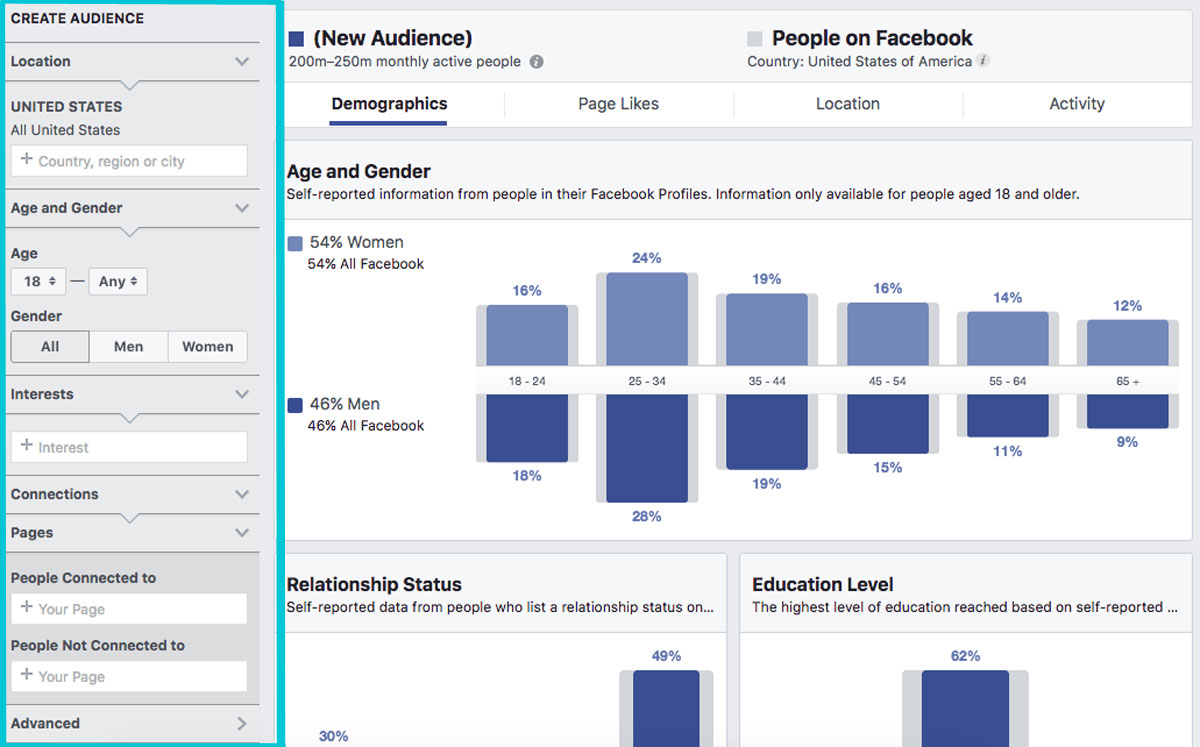
When you enter Audience Insights, Facebook will ask you, if you want to analyse data for everyone on Facebook, or if you want to evaluate people connected to your page or a custom audience.
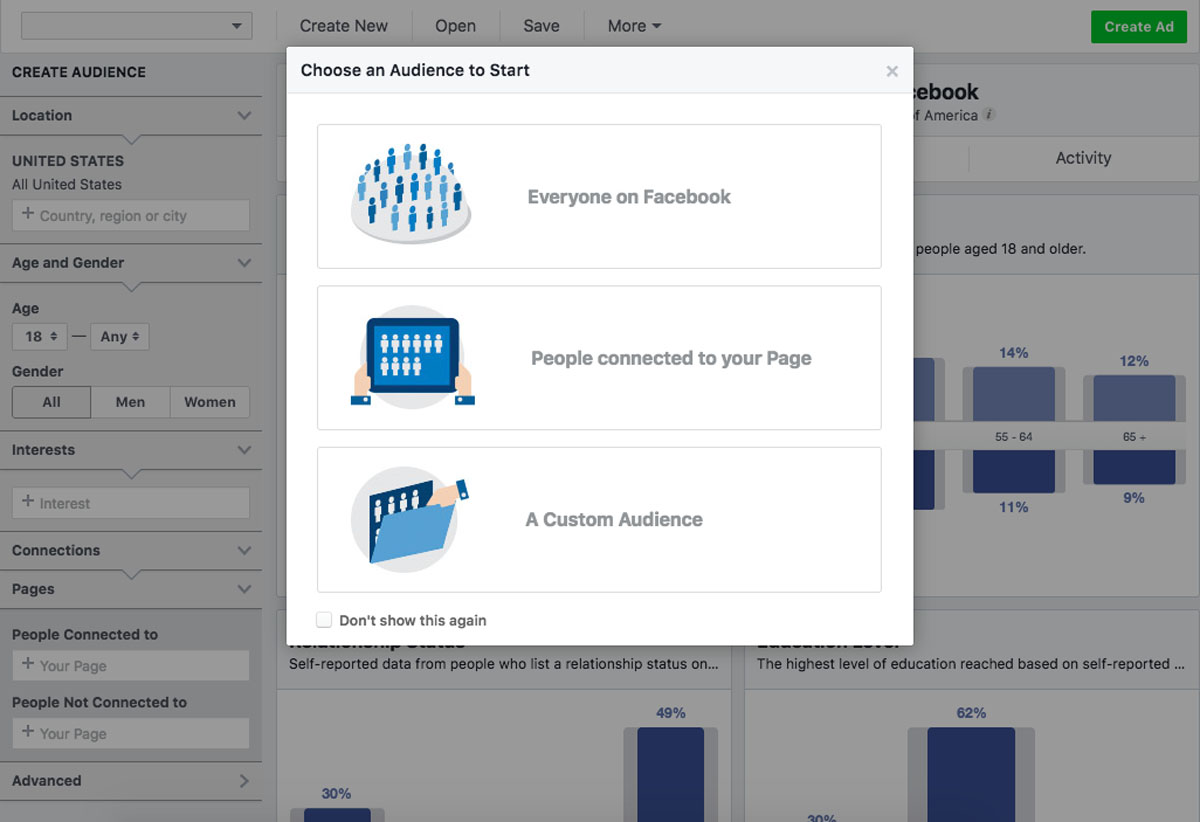
If you already have a big audience of people connected to your page or a large database of customer profiles saved as a custom audience, then using the two latter options provides a great opportunity to find out more about your audience.
For example, by checking out the insights of the WeTravel brand, we were able to see the following:
1. Users in our audience also like other travel companies like G Adventures, Outdoor Project, Intrepid and Interval International. This allows us to start watching these pages to see what is working for them.

2. 54% of our audience is female, with 43% of the total audience aged between 24-44. Also most of the audience is either single or married and have a college degree. This can help us think about the types of tours we advertise and the language, tone and style that would resonate well with this audience.
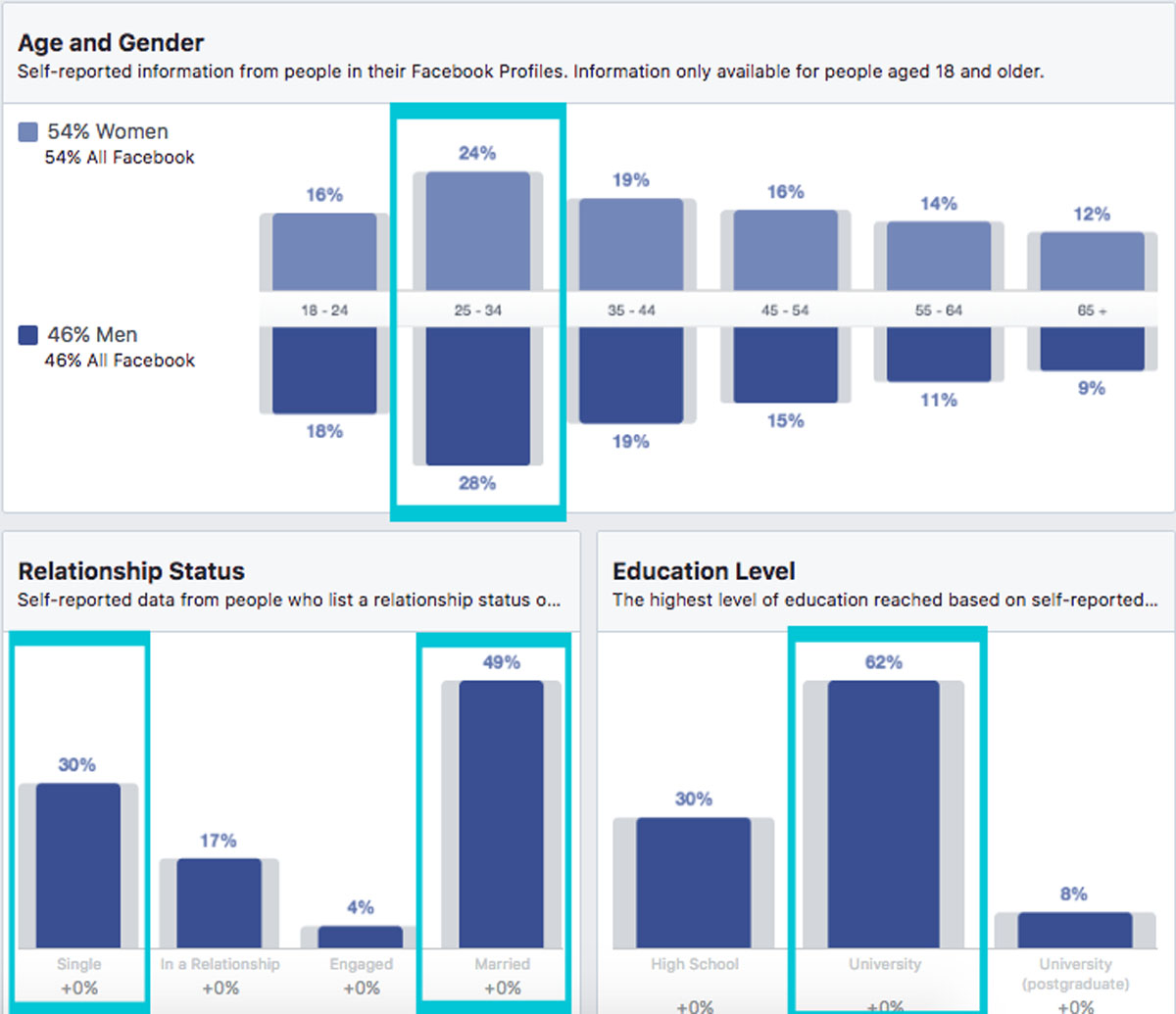
3. Also, our audience is highly engaged. Users in our audience are much more likely to click on an Ad compared to the average Facebook user.
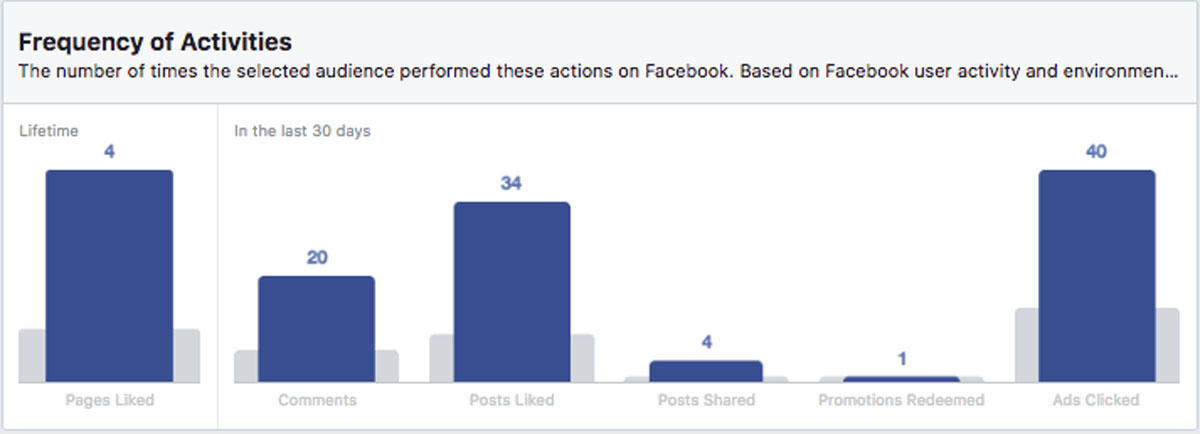
As you can see there is a huge amount of information you can uncover about your target audience. The above only scratches the surface.
However, if you have no existing Facebook audience to analyse, then you will need to use Audience Insights to filter for your ideal customer profile.
There is no set recipe on how you use Audience Insights, but as a starting point it is always a good idea to sketch out what your ideal customer looks like.
We spent some time looking at customer profiles in our article on Value Proposition and Brand; so you probably already have a good idea of who your perfect customer is, but to develop this more, take a minute to complete the exercise below.
QUICK EXERCISE
On a piece of paper jot down the main characteristics of your ideal customer, answer these questions:
- What is their age?
- Where do they live?
- What is their relationship status?
- Do they have children?
- What sort of income do they make?
- What level of education do they have?
- What are their interests?
- Which brands do you think they like?
- What are their politics?
- Where do they get their information? From what news sites?
- What TV programs or books do they like?
Using the customer profile from above you can then start to develop an audience profile. It may look something like this.
![]()
Pro Tip: Use the Page Likes tab to drive down into interests. For example, if you are an adventure travel operator you could look for users who like the Page of a major competitor and then target these users.
Campaign Set-up and Ads
Once you are super clear on the audience you want to target, the next step to success with Facebook adverting is in setting up your campaign and creating engaging ads.
There are a few key steps to setting up a Facebook campaign:
- Campaign Objective
- Audience
- Placement, Budget and Schedule
- Ads
Campaign Objective
Campaigns always start with a clear objective – i.e. the goal you are looking to achieve with a campaign.
Facebook designates objectives into three main buckets: Awareness, Consideration and Conversion.
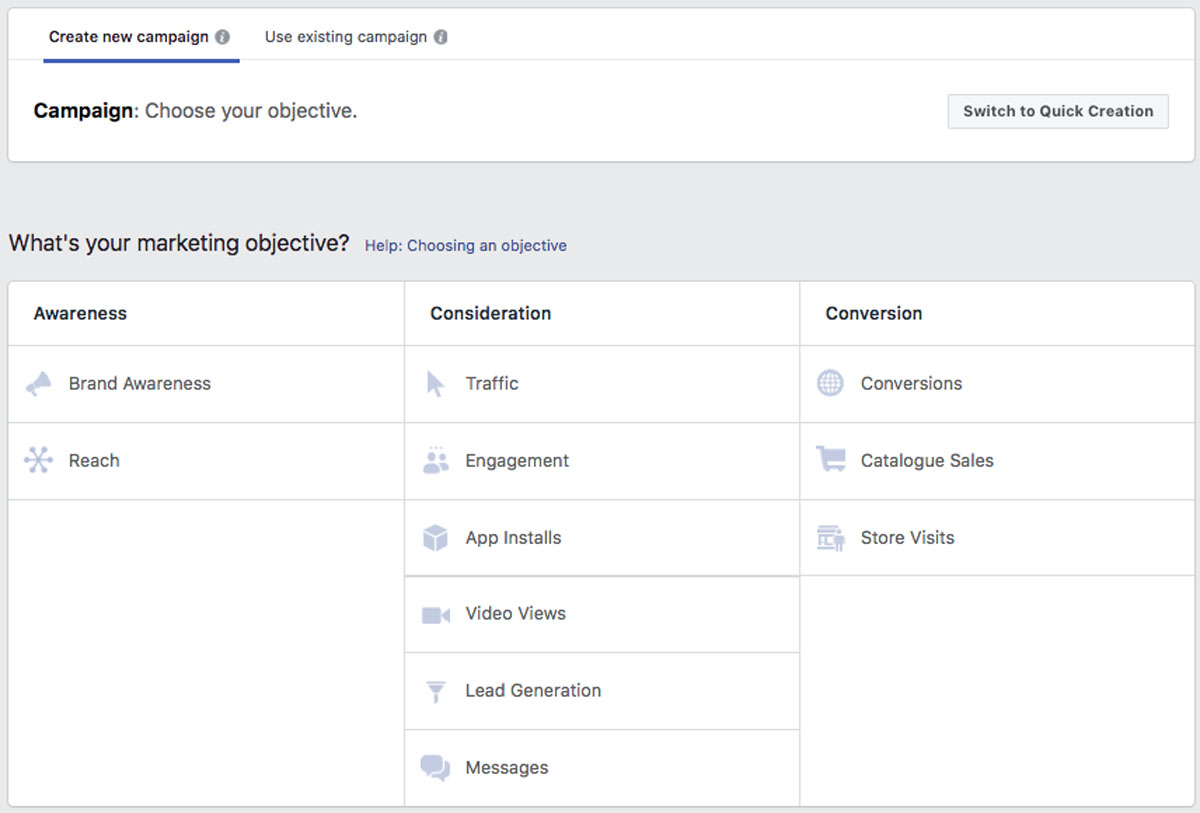
You should think carefully about the objective you are trying to achieve and how your target audience may respond to the objective.
Many newbies set up a campaign and immediately try target for the highest value action – conversions!
This is a critical mistake and will end up delivering poor results and a negative ROI.
A campaign objective can be informed by thinking about where your target audience is in terms of your sales funnel.
As a rule of thumb for travel operators, a target audience of users generated from your Facebook Pixel or email list (i.e. warmer targets) will be lower down on your sales funnel and may respond well to a conversion target.
Whereas an audience generated from within Audience Insights, who hasn’t been exposed to your brand or tours, may be higher up the funnel and would respond well to a brand awareness campaign or consideration campaign, instead.
Audience
After you have defined your campaign objective, Facebook will run you through a sequence of steps to setup your target audience. If you have already created a custom audience, you can apply this here or simply use the filtering tool to define your audience.
Facebook will provide you with an estimation of the size and reach of your target audience.
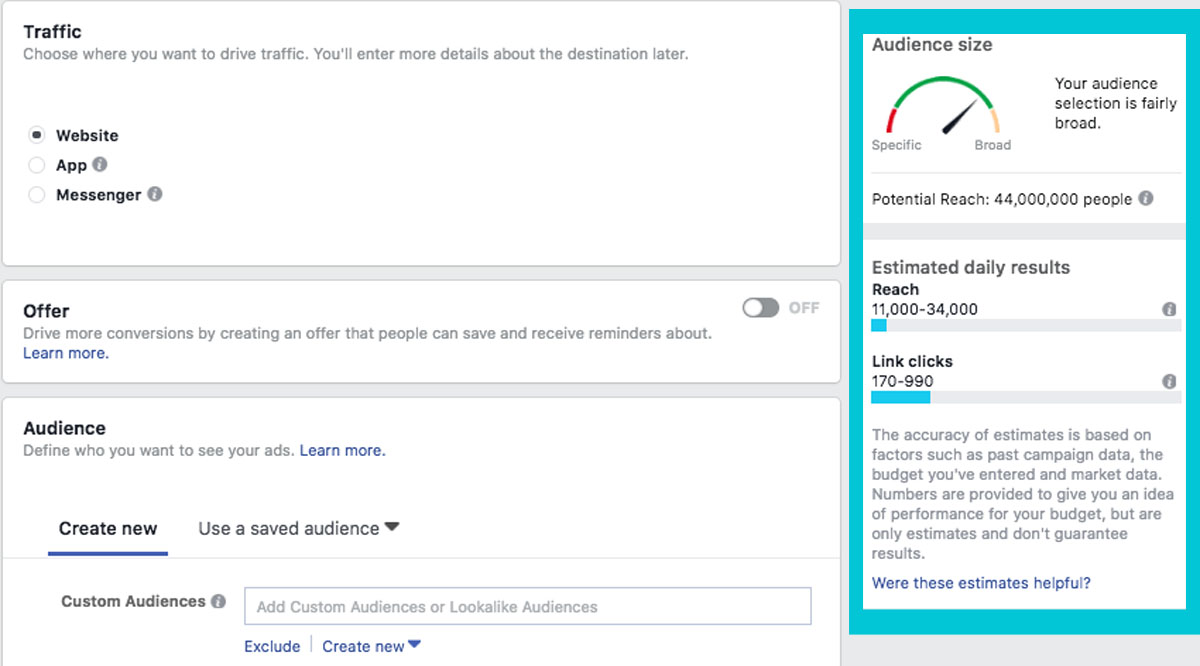
Pro Tip: Best practice is to start with a relatively large audience that is tightly defined (i.e. a few hundred thousand people), and then to refine your audience as you get more performance data from your ads.
Placement, Budget and Schedule
Facebook provides two options in terms of placing your ads.
Pro Tip: Its recommended approach for advertisers is to use its automatic placements feature. This means you don’t need to worry about placement and your ads will appear where Facebook thinks they will perform best. In general, this is a good option, but it does mean that your ads can end up being featured in random places, like their audience network (think of the ads you see when you use apps or games on your phone), and in Facebook Messenger.
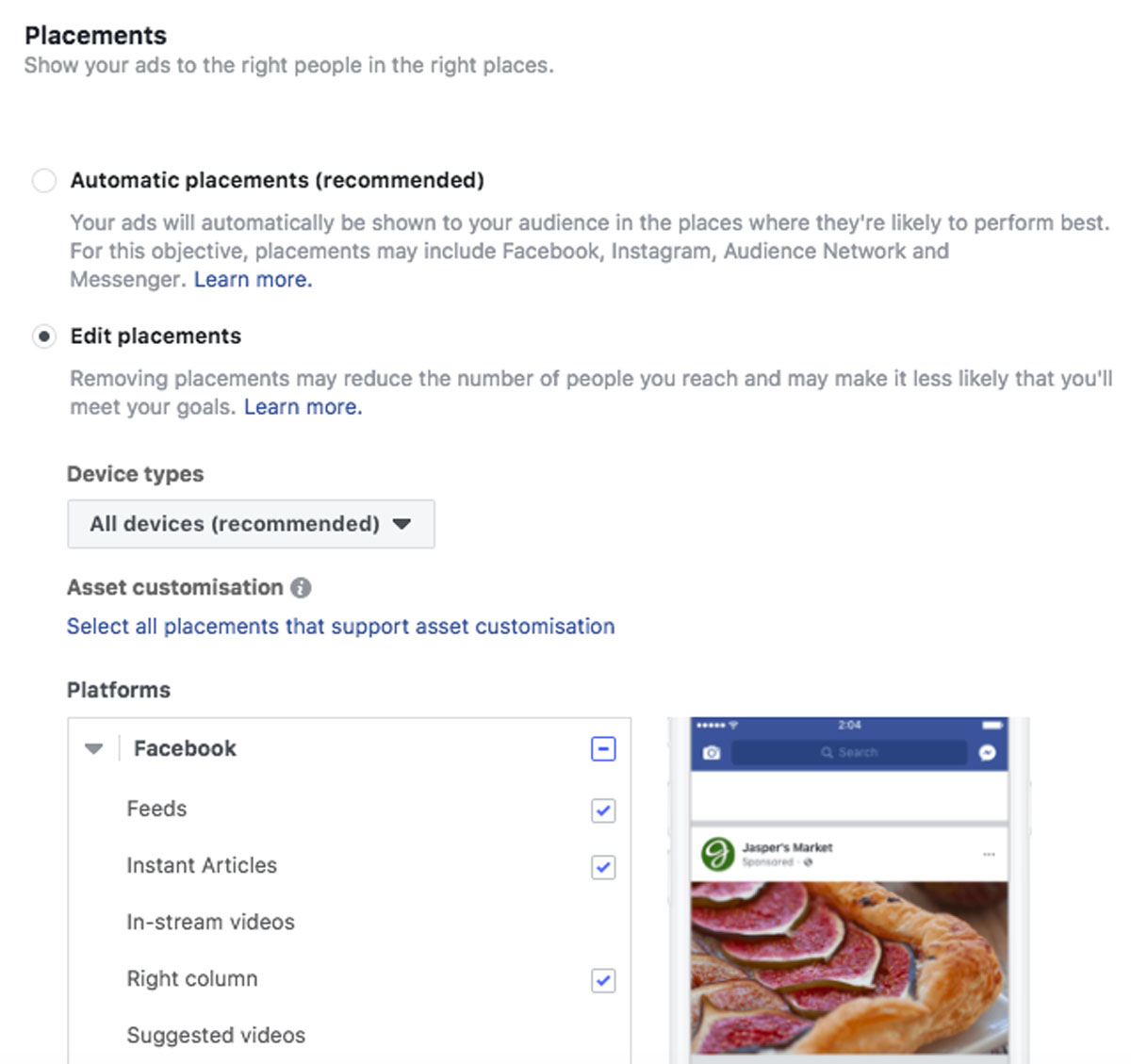
If you think you have a good understanding of your target audience then editing the placement of your ads can be a great option.
This gives you full control on where your ads will be seen. In our experience, you want to ensure that your ads are optimized for placement on All Devices, but you may decide to uncheck placement options like the Right Column, Facebook Messenger and the Audience Network.
In terms of budgeting and scheduling, if you are just starting out, we suggest you begin with a small budget of $5-$10 per day per campaign. To be able to collect enough data and compare and contrast performance of your ads, you will need to run the ads for at least one week.
QUICK EXERCISE (5.3)
Think about the target audience profile you have created. Where is it in the sales funnel? What campaign objective would best suit this target audience?
Now think about the lifetime value of each customer (LTV). For example, if you are selling tours for $1000 per person, making a 30% margin, and most customers buy twice from you, then your LTV is $600. As a general rule in advertising, you might spend one third of the LTV in acquiring a customer. In this case – around $200 per customer.
Consider how you will spread that budget across the sales funnel to move users from awareness about your brand and tours, to consideration, and then eventually – conversion.
Make sure that you measure the right performance metric for each type of campaign objective. For example, if you are optimizing your campaign goal for post engagement, you shouldn’t expect conversions.
As we discuss in the final section of this article, testing and refining your campaigns is key to successful Facebook marketing. This can mean you lose money before you start winning.
Ads
Finally, once you have completed your Campaign and Ad Set information, the last step is to create your ads.
Facebook offers all sorts of highly customizable ad formats, so it is worth testing a few to see which get the best results. Generally, for static ads (i.e. those without video content), the Single Image format or the Carousal format works well.

Facebook allows you to create a number of variations per ad format. For example, with the single image format you can create up to 6 variations.
This is a great feature as it allows advertisers to test different imagery, headlines, description text and calls to action (CTAs) to see which ads are performing well.
You can imagine your ad setup for a campaign as follows. Each ad variation can be tested and refined as your campaign develops.
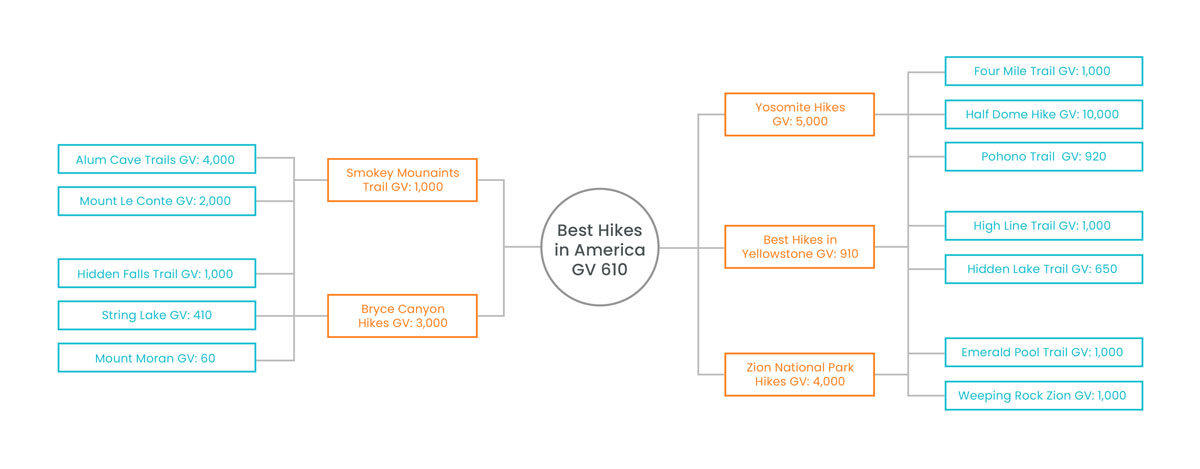 Again, there is no secret recipe to creating ads that get great engagement, but some best practices do apply.
Again, there is no secret recipe to creating ads that get great engagement, but some best practices do apply.
Experience tells us that great imagery is an absolute must. The question to ask yourself when choosing imagery is: Does this image make me want to stop for a second to find out more or would I just scroll past it?
A great image should grab your attention and create an emotional connection with the viewer.
The headline should be catchy. The use of capitalization, punctuation and numbers works well. Just make sure your ads are in compliance with Facebook’s advertising policies, as you do not want to get your account banned.
Finally, many advertisers find that story-telling works better than single image ad formats. When you think about it, we all love stories. The carousal ad format can provide an exciting opportunity to tell a story about your brand and tours.
Suggested Reading
Testing, Refining and Testing Again
If there is one area that Facebook has completely revolutionized in terms of advertising, it is the ability to monitor ad performance, and make changes in real time.
If you think you can set up a Facebook campaign and just let it run its course, you are making a huge rookie error.
Facebook’s performance metrics allow you to drill down in real time to see which ad variations are working, and which aren’t. You can then make edits and see the results almost immediately.
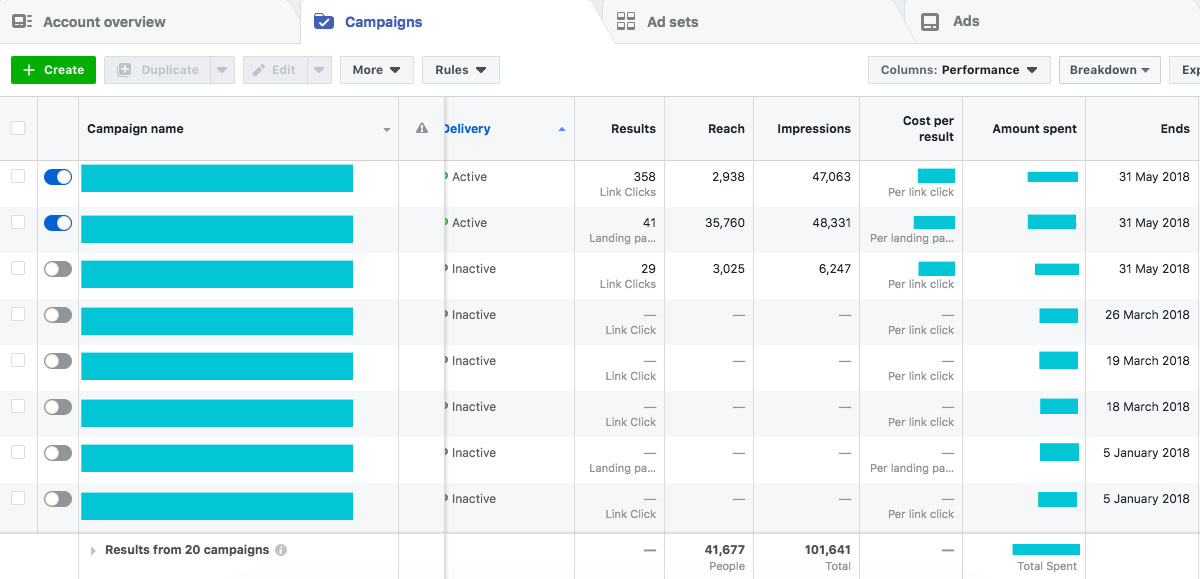
From the Ad Manager, you can see all of your campaigns and get a quick snapshot of how they are performing. For example, you can see how your objective is performing, how many people you have reached and how much you have spent.
You can then click into a campaign to see how individual ad sets are performing. From here you can easily edit and refine your target audience, placement, budget and schedule of the ad set.
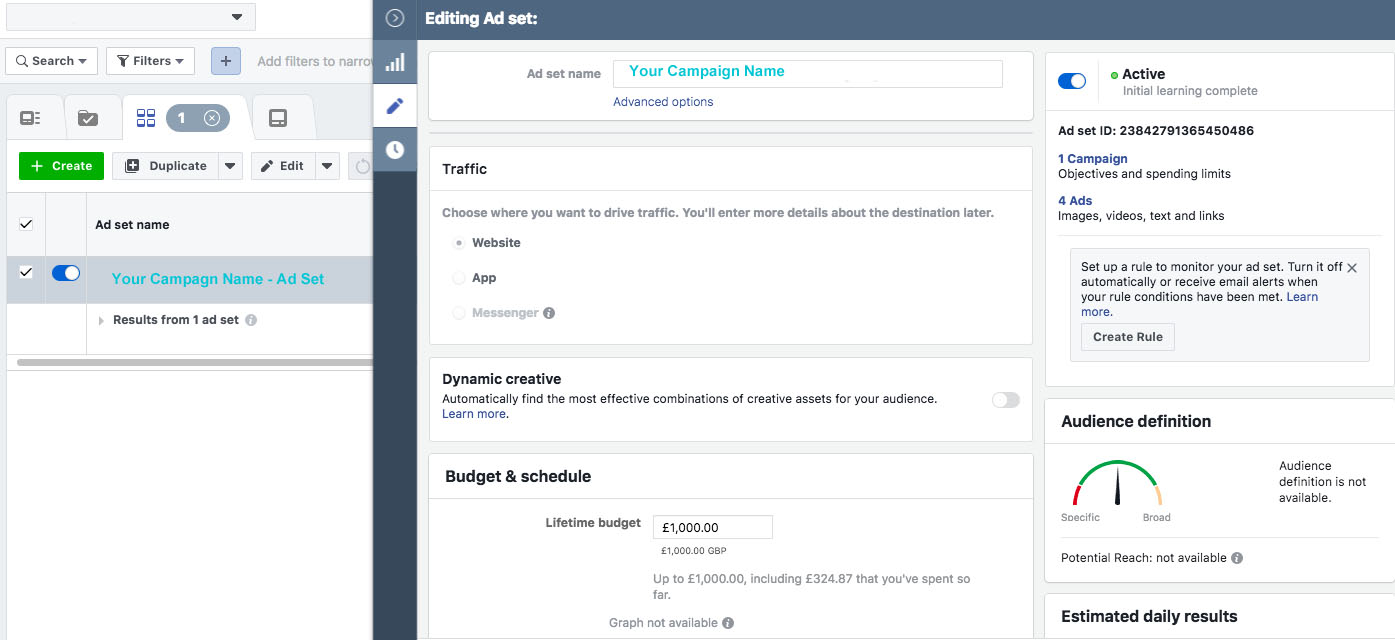
You can also then review and edit your individual ads.
For example, out of the four ad variations below, it is clear that option 1 is performing the best. It receives the highest reach and gets the lowest cost per click. As advertisers, we can use this information to edit the other variations or pause them completely and focus on the winning ad only.

QUICK EXERCISE
Set aside a few $100s to try out Facebook advertising. See this money as an investment in learning and don’t put too much pressure on yourself to get results.
Start strategically. Think about your target audiences and what objectives you want to achieve.
Then setup a series of ads and over a period of a few weeks, make sure to login each day to check performance and refine your ads.
Note which strategies are working for you and where you are meeting your campaign objective. Double down on what works and discard what doesn’t work.
Summary
As a travel operator, it is getting increasingly more difficult to acquire customers via organic traffic and can be very expensive to use traditional advertising or Google PPC advertising, if you don’t know what you are doing.
Facebook has leveled the playing field and has allowed an advertiser with very little budget to reach a travel-seeking audience with precision focused ads.
It is also very scalable. With real time performance metrics, you can adjust and refine campaigns without having to wait days or weeks to figure out what went wrong.
If you are sitting on the fence with Facebook advertising we highly recommend you give it a try.
Did you enjoy this article? Get a FREE e-book: 150-page guide that covers everything from establishing a winning travel brand to delivering a market-leading service.
New resources, straight to your inbox
We’re committed to your privacy. WeTravel uses the information you provide to us to contact you about our relevant content, products, and services. You may unsubscribe at any time.



